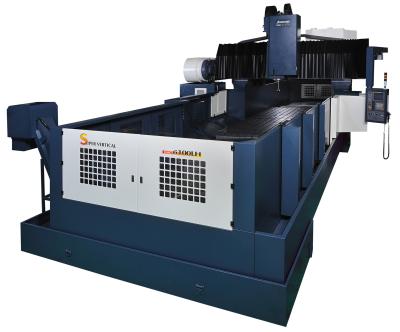
Johnford DMC LH Series double-column moving table bridge mills join the expansive lineup of Johnford double-column and sliding double-column machining centers, bringing capacity and affordability to large-part machining. The LH series features 110” (,2800mm) in Y and 122” (3,100mm) to 244” (6,100mm) in X in 39.4” (1 meter) increments. Standard Z axis travel is 32” with 42” and 60” optionally available.
Johnford double columns are created from massive Meehanite iron castings. These bridge mills have a long base casting with complete support of the table over the full X-axis travel, allowing massive loads to be machined. The Y and Z axes hold fixed loads at all times while the X-axis carries the only dynamic load, allowing for tight machining and tight tolerances during high-speed machining operations. Because there is no table overhang, X-axis pitch and yaw are eliminated. The spindle centerline-to-column distance is minimized offering further rigidity.
The machine’s heavily ribbed cast iron construction provides long tool life and part surface finish. The combination of complete surround table guarding with twin screw-type conveyors and a caterpillar conveyor ensures complete chip removal with little manual cleaning. Additionally, Finite Element Analysis (FEA) is used to design each bridge mill, simulating the effects of real world conditions, including vibration, heat, fluid flow and other physical impacts.
The DMC-3100LH, 4100LH, 5100LH, and 6100LH all feature rigid box ways in Y and Z and Schneeberger roller ways in X for high load carrying capacity. Heavy duty 35HP (50HP opt.) 2 speed gearbox driven spindles provide heaving cutting power and torque. The standard 40 tool ATC (60, 80, 120 opt.) provide fast reliable tool changes.
The DMC LH series is available in numerous customizable configurations including extended Z-axis travels, full automatic five-face head changing, and full 5-axis. A variety of options are available to tailor the machines to specific applications such as aerospace and mold/die. FANUC, Mitsubishi, Siemens, Heidenhain and Fagor controls are available based on customer preference.
Contact Details
Related Glossary Terms
- centers
centers
Cone-shaped pins that support a workpiece by one or two ends during machining. The centers fit into holes drilled in the workpiece ends. Centers that turn with the workpiece are called “live” centers; those that do not are called “dead” centers.
- milling machine ( mill)
milling machine ( mill)
Runs endmills and arbor-mounted milling cutters. Features include a head with a spindle that drives the cutters; a column, knee and table that provide motion in the three Cartesian axes; and a base that supports the components and houses the cutting-fluid pump and reservoir. The work is mounted on the table and fed into the rotating cutter or endmill to accomplish the milling steps; vertical milling machines also feed endmills into the work by means of a spindle-mounted quill. Models range from small manual machines to big bed-type and duplex mills. All take one of three basic forms: vertical, horizontal or convertible horizontal/vertical. Vertical machines may be knee-type (the table is mounted on a knee that can be elevated) or bed-type (the table is securely supported and only moves horizontally). In general, horizontal machines are bigger and more powerful, while vertical machines are lighter but more versatile and easier to set up and operate.
- pitch
pitch
1. On a saw blade, the number of teeth per inch. 2. In threading, the number of threads per inch.

